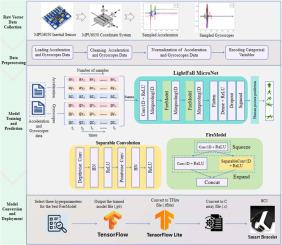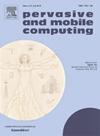MicroFallNet:用于智能手环上的实时跌倒检测的轻量级模型
IF 3.5
3区 计算机科学
Q2 COMPUTER SCIENCE, INFORMATION SYSTEMS
引用次数: 0
摘要
跌倒是老龄人口的一个主要公共卫生问题,导致严重伤害、丧失独立性和增加医疗保健费用。虽然可穿戴设备提供了有前途的解决方案,但现有算法往往受到微控制器(MCU)在计算能力、内存和能耗方面的限制。为了克服这些挑战,我们引入了MicroFallNet,这是一种轻量级的卷积神经网络,旨在准确有效地检测跌倒。MicroFallNet采用新颖的FireModel架构,结合挤压和扩展层来优化计算效率并增强特征提取。该算法在UMAFALL和FallAllD数据集上表现出优异的性能,几何平均准确率分别达到97.91%和97.86%,显著优于传统方法。此外,MicroFallNet在各种微控制器上展示了出色的部署效率,特别是在ESP32智能腕带平台上表现出色,其推理时间仅为30.3毫秒。这种能力使MicroFallNet非常适合实时跌倒检测应用,推动了老年人可穿戴设备的发展,并为智能健康监测领域做出了重大贡献。我们的代码将在https://github.com/qwer12330/MicroFallNet-A-Lightweight-Model-for-Real-Time-Fall-Detection-on-Smart-Wristbands-Using-Sm上公开提供。本文章由计算机程序翻译,如有差异,请以英文原文为准。

MicroFallNet: A lightweight model for real-time fall detection on smart wristbands
Falls are a major public health concern for the aging population, leading to significant injuries, loss of independence, and increased healthcare costs. While wearable devices present promising solutions, existing algorithms are often hindered by the limitations of microcontroller units (MCU) in terms of computational power, memory, and energy consumption. To overcome these challenges, we introduce MicroFallNet, a lightweight convolutional neural network designed for accurate and efficient fall detection. MicroFallNet features a novel FireModel architecture, incorporating Squeeze and Expand layers to optimize computational efficiency and enhance feature extraction. The proposed algorithm demonstrates superior performance on the UMAFALL and FallAllD datasets, achieving geometric mean accuracies of 97.91 % and 97.86 %, respectively, significantly surpassing traditional methods. Additionally, MicroFallNet showcases excellent deployment efficiency across various microcontrollers, particularly excelling on the ESP32 smart wristband platform, where it achieves an inference time of just 30.3 milliseconds. This capability makes MicroFallNet ideally suited for real-time fall detection applications, advancing the development of wearable devices for the elderly and contributing substantially to the field of smart health monitoring. Our code will be publicly available at https://github.com/qwer12330/MicroFallNet-A-Lightweight-Model-for-Real-Time-Fall-Detection-on-Smart-Wristbands-Using-Sm.
求助全文
通过发布文献求助,成功后即可免费获取论文全文。
去求助
来源期刊

Pervasive and Mobile Computing
COMPUTER SCIENCE, INFORMATION SYSTEMS-TELECOMMUNICATIONS
CiteScore
7.70
自引率
2.30%
发文量
80
审稿时长
68 days
期刊介绍:
As envisioned by Mark Weiser as early as 1991, pervasive computing systems and services have truly become integral parts of our daily lives. Tremendous developments in a multitude of technologies ranging from personalized and embedded smart devices (e.g., smartphones, sensors, wearables, IoTs, etc.) to ubiquitous connectivity, via a variety of wireless mobile communications and cognitive networking infrastructures, to advanced computing techniques (including edge, fog and cloud) and user-friendly middleware services and platforms have significantly contributed to the unprecedented advances in pervasive and mobile computing. Cutting-edge applications and paradigms have evolved, such as cyber-physical systems and smart environments (e.g., smart city, smart energy, smart transportation, smart healthcare, etc.) that also involve human in the loop through social interactions and participatory and/or mobile crowd sensing, for example. The goal of pervasive computing systems is to improve human experience and quality of life, without explicit awareness of the underlying communications and computing technologies.
The Pervasive and Mobile Computing Journal (PMC) is a high-impact, peer-reviewed technical journal that publishes high-quality scientific articles spanning theory and practice, and covering all aspects of pervasive and mobile computing and systems.
 求助内容:
求助内容: 应助结果提醒方式:
应助结果提醒方式:


